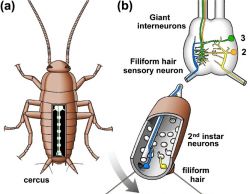The first-instar cockroach quite easily avoids its predators. This is because each of its posterior cerci has a pair of sensory hairs, which detect even the slightest air movement. The four sensory neurons which innervate these hairs synapse with giant interneurons (GIs) in the terminal ganglion which in turn synapse with interneurons and leg motoneurons in thoracic ganglia. This neural circuit mediates the animal's escape behaviour.
 The first-instar cockroach cercal system. (a) A first-instar larval cockroach, with the dorsal body wall opened to show the abdominal nerve cord. Each cercus bears two filiform hairs. (b) The proximal segment of the left cercus, with the dorsal surface removed to reveal the lateral (blue) and medial (yellow) filiform hair sensory neurons. The lateral neuron sends an axon to the terminal abdominal ganglion and is excited by the movement of the hair (curved arrow); the axon and arborisation of the medial neuron are shown on the opposite side of the ganglion. Two of the seven contralateral giant interneurons (GIs), GI2 (orange) and GI3 (green), are shown. Cell bodies of the developing array of second-instar neurons are situated more proximally to the fully differentiated lateral and medial sensory neurons.
The first-instar cockroach cercal system. (a) A first-instar larval cockroach, with the dorsal body wall opened to show the abdominal nerve cord. Each cercus bears two filiform hairs. (b) The proximal segment of the left cercus, with the dorsal surface removed to reveal the lateral (blue) and medial (yellow) filiform hair sensory neurons. The lateral neuron sends an axon to the terminal abdominal ganglion and is excited by the movement of the hair (curved arrow); the axon and arborisation of the medial neuron are shown on the opposite side of the ganglion. Two of the seven contralateral giant interneurons (GIs), GI2 (orange) and GI3 (green), are shown. Cell bodies of the developing array of second-instar neurons are situated more proximally to the fully differentiated lateral and medial sensory neurons.
When the first instar moults into the second instar, each cercus bears an array of 39 hairs, and their associated sensory neurons. In a previous study with my long-term collaborator Jonathan Blagburn (San Juan http://www.neuro.upr.edu/faculty/blagburn/blagburn.html ), we examined the axonal arborisations and synaptic connections of the 25 distal-most of the second-instar neurons to 10 giant interneurons in the CNS. The transcription factor Engrailed (En) is expressed only in the medially born sensory neurons, which suggested it could work as a positional determinant of sensory neuron identity. Using dsRNA interference to abolish En expression, the axonal arborisation and synaptic outputs of an identified En-positive sensory neuron changed so that it came to resemble a nearby En-negative cell, which was itself unaffected. We thus demonstrated directly that En controls synaptic choice, as well as axon projections.
But is escape behaviour affected as a result of this miss-wiring? In a recent study led by my ex-graduate student, David Booth, analysis of escape turn angles reveals subtle changes in behaviour after En knockout, which we are able to explain in terms of the expected changes in GI directional sensitivity when normally En-expressing neurons make connections more typical of En-negative neurons.
Our analysis of cockroach behaviour, in collaboration with Paolo Domenici http://150.145.38.39/IAMC/staff/paolo-domenici/domenici-paolo?set_language=en has become more sophisticated with our recent demonstration that individual cockroaches are able to keep the predator guessing, making each escape unpredictable by running along one of a set of preferred trajectories at fixed angles from the direction of the threatening stimulus. These results provide a new paradigm for understanding the behavioral strategies for escape responses, underscoring the need to revisit the neural mechanisms controlling escape directions in the cockroach and similar animal models, and the evolutionary forces driving unpredictable, or “protean”, anti-predator behaviour.


